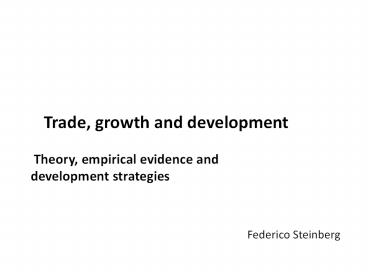Multilateral organisms dealing with International Trade: a survey PowerPoint PPT Presentation
1 / 14
Title: Multilateral organisms dealing with International Trade: a survey
1
Trade, growth and development Theory,
empirical evidence and development strategies
Federico Steinberg
2
Outline
- The present trading context
- The logic of trade liberalization
- The political economy of trade policy
- The arguments for protection
- The empirical evidence what do we know?
- Some historical lessons
- What should emerging economies do?
3
The present trading context
- Wide spread retoric of virtues of trade openness
fostered by multilateral institutions - IMF / World Bank
- Washington Consensus policies (ie. structural
adjustment plans that include trade
liberalization) - The globalizers grow faster (SE Asia, China,
India, etc) - WTO
- Strong pressures by the north for
liberalization and harmonization of national
standards - New topics on the trade agenda (trade-related
issues) - But Doha negotiations collapsed
4
Average applied tariffs (2009) Average applied tariffs (2009) Average applied tariffs (2009)
Developed countries Developing countries
Agriculture 16 17,7
Textiles 7,5 17
Manufactures 1,9 9
Total (excluding services) 2,9 9,9
5
Free trade is good because it
- Increases economic efficiency
- Reduces consumers prices
- Allows to reap the benefits of economies of scale
and increases product variety - Promotes competition
- Speeds up technological transfer
- Increases welfare and promotes growth
- Non economic arguments
- Reduces rent-seeking activities (corruption)
- Political stability
6
The political economy of trade policy
- Trade liberalization redistributes income
(Stolper-Samuelson theorem). With liberalization - Owners of the relatively scarce factors of
production lose - Owners of the relatively abundant factors of
production win - Examples
- In China unskilled labor is relatively abundant ?
wages increase with trade liberalization - In Europe, low skilled labor is relatively scarce
? wages decrease with trade liberalization - Income redistribution through trade policy is
economically inefficient and not transparent
7
Arguments for protection
- Infant industry protection (Mill, Hamilton,
List) - Latecomers are not able to compete on a level
playing field with advanced/industrialized
countries they need temporary protection - Critics trade protection is not the best policy
to solve this problem - Strategic trade policy/picking winners
- On strategic sectors with high profits and
positive externalities it is justified to
protect (subsidies, RD) - Critique how do you pick those sectors?
- Historical argument most rich countries were
protectionist - Non-economic argument security concerns, high
politics - Other (mostly incorrect) arguments terms of
trade, job protection, Balance of Payments
deficits,
8
Empirical evidence what do we know?
- Rich countries tend have relatively open trade
policies (excluding agriculture) - So, does openness cause growth?
- ?
Trade liberalization
Economic growth
9
First problem which variable is more important
for growth? Impossible to discern
Macroeconomic stability
Poverty reduction
Good institutions/regulation
Trade liberalization
Exchange rate policy
Economic growth
Financial liberalization
10
Second problem
- In practice it is very difficult to measure
protectionism - Tariffs are easy to compute
- But protectionism includes
- Non-tariff barriers
- Subsidies
- Regulatory barriers
11
Empirical evidence what do we know?
12
The most relevant econometric studies (Edwards
1998, Rodrik and Rodriguez 2000, Winters 2004, )
show that
- It is not possible to establish a clear causal
relationship between openness and growth - Over long periods of time, open economies tend to
grow faster (dynamic gains from trade) - Very closed economies grow very slowly (lack of
technology and competition, ex North Korea) - Strategic trade liberalization, combined with
other sound policies (macro, institutional, etc),
accelerates growth (but trade liberalization is
not enough) - Once a country has developed, it tends to
increase trade liberalization (so maybe growth
causes openness)
Thus, we can conclude that
13
Some historical lessons
- United Kingdom successful unilateral trade
liberalization (1846), but it was a hegemonic
power - Germany and USA (XIX century) used protectionism
to promote industry and manufactures - Japan (1950s-1960s), South Korea (1960s-1970s)
and other South East Asian countries developed
with protection and active industrial policies to
promote exports in strategic sectors - China and India gradualism, selective protection
and control over FDI
14
What should emerging economies do?
- Integrate strategically in the global economy
following its comparative advantage - Maintain policy space (industrial policy, IPR,
FDI regulation, credit allocation to key sectors,
etc) - Reject new trade issues that reduce political
autonomy (Singapore issues, environment, labor) - Foster multilateral, rules-based integration
- Regional/bilateral treaties only when political
autonomy is not reduced (avoid asymmetries)

